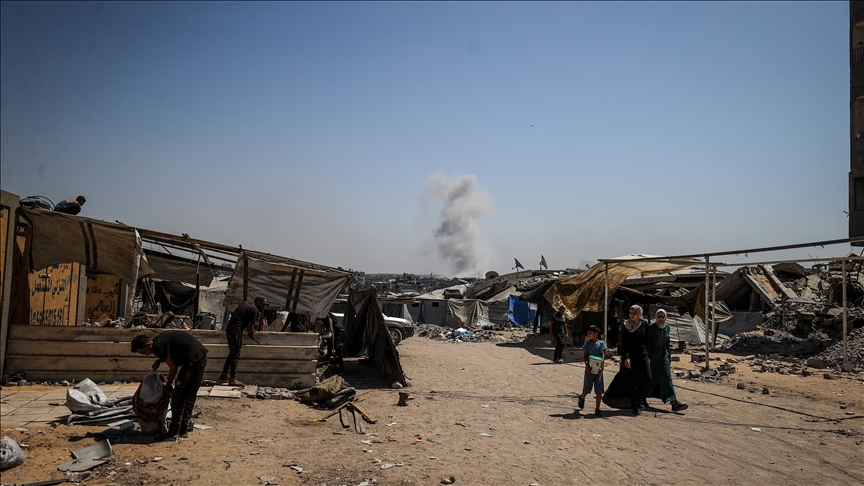Scorched-earth tactics: Israel pushes ahead with plan to occupy Gaza City
Israeli military intensifies bombardment, ground operation on Gaza City’s northern, southern flanks, pressing civilians to flee under fire as part of plan to reoccupy enclave

GAZA CITY, Palestine/ISTANBUL
The Israeli army has massed forces backed by land, air and sea cover, employing scorched-earth tactics to occupy Gaza City, home to 1 million Palestinians on less than 22 square miles, in one of the world’s most densely populated cities.
The military has escalated strikes across Gaza City, especially in eastern neighborhoods along the northern and southern fronts, in what it calls “Operation Gideon’s Chariots 2,” a push to reoccupy the city that began with the destruction of the Zaytoun district in the southeast.
Israeli forces declared Gaza City a “dangerous combat zone” as they stepped up bombardment before dawn Friday.
Defense Minister Israel Katz approved the operation on Aug. 21, following more than two weeks of attacks in Zaytoun that spread into the adjacent Sabra neighborhood.
At the same time, Israeli units launched an offensive north of Gaza City into Jabalia and al-Nazla -- areas that border the city from al-Saftawi and Sheikh Radwan.
In recent days, the army expanded strikes east of Sheikh Radwan, targeting residential apartments with drone-dropped bombs and gunfire, while snipers pursued fleeing civilians and displaced families.
The army has also used explosive-laden armored vehicles, disabled troop carriers packed with tons of explosives, to demolish residential blocks and infrastructure. When detonated, the blasts send shockwaves for miles, flattening entire areas.
For months, eastern Sheikh Radwan had served as a refuge for thousands displaced from northern Gaza and the eastern districts of the city. But sustained shelling has forced residents to flee again, this time to western Gaza City or farther south.
Israel’s state-run Kan broadcaster reported Friday that the government is preparing to end humanitarian aid airdrops above Gaza City in the coming days, a move seen as an effort to force hundreds of thousands of residents to flee south before a ground incursion.
Worsening conditions
A Palestinian security source told Anadolu that conditions in eastern Gaza City along the northern and southern axes are deteriorating rapidly.
The source, who spoke on condition of anonymity, said Israeli forces are using explosive-laden vehicles and quadcopter drones that drop bombs and fire on civilians, effectively replacing soldiers in pursuit and encirclement operations.
Loudspeakers mounted on drones have broadcast evacuation orders, forcing residents to leave under fire, said the source.
In northern Gaza City, the source said Sheikh Radwan has turned from a crowded neighborhood into an almost empty zone after two weeks of strikes and mass displacement.
Abu Iskandar, once considered a haven and home to vital markets, has now become “one of the most dangerous areas in Gaza City,” the source added.
Most residents are fleeing west toward central Gaza City, while some have moved south, said the source.
At the al-Nazla, Abu Shreikh roundabout, and Joura al-Saftawi, Israeli forces advance slightly each day, planting explosive vehicles before pulling back, he added.
Conditions in al-Saftawi, north of the Jalaa roundabout, are also perilous after most residents fled.
In the south, Sabra and Zaytoun remain under heavy bombardment and demolition.
Civil defense spokesman Mahmoud Bassal told Anadolu earlier this month that Israeli forces had destroyed more than 1,500 residential buildings in Zaytoun since August using airstrikes and explosive vehicles. Sabra has also been under sustained attacks.
Mass displacement
With bombardments intensifying in northern and southern Gaza City, Palestinians have fled under dire conditions, many sleeping in the streets of western neighborhoods with no tents or shelter after abandoning homes and makeshift camps.
Many cannot afford transportation to southern Gaza because of worsening poverty and the scarcity of vehicles.
Residents fear the coming days will bring even harsher assaults, compounding the famine and displacement crisis.
On Aug. 8, Israel’s Cabinet approved Prime Minister Benjamin Netanyahu’s plan for the gradual reoccupation of the entire Gaza Strip, beginning with Gaza City.
Israel has killed more than 63,000 Palestinians in Gaza since October 2023. The military campaign has devastated the enclave, which is facing famine.
Last November, the International Criminal Court issued arrest warrants for Netanyahu and his former Defense Minister Yoav Gallant for war crimes and crimes against humanity in Gaza.
Israel also faces a genocide case at the International Court of Justice for its war on the enclave.








